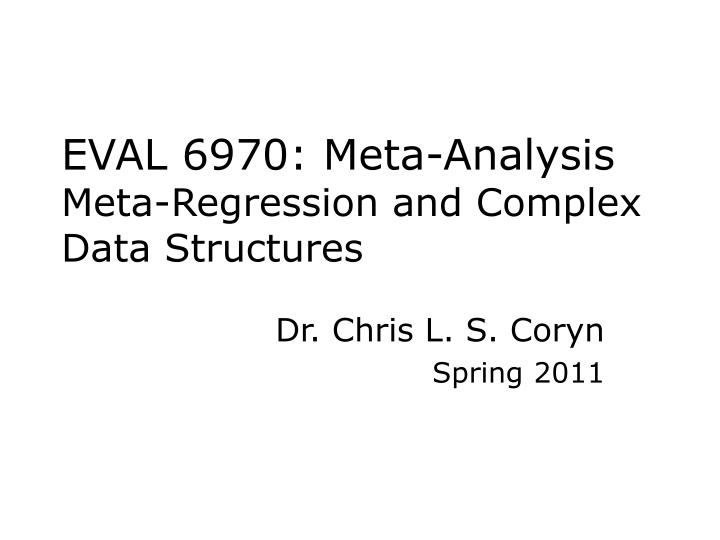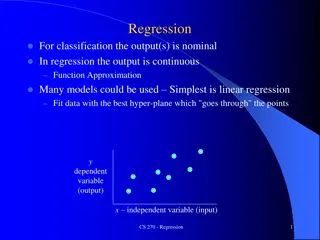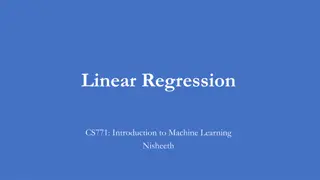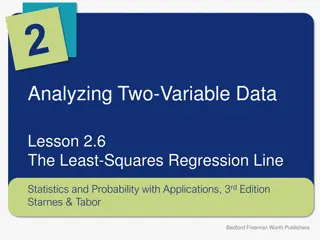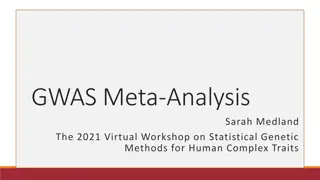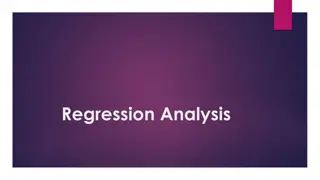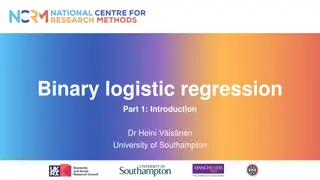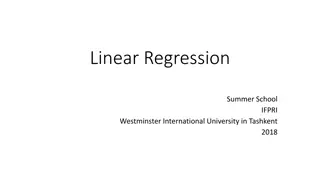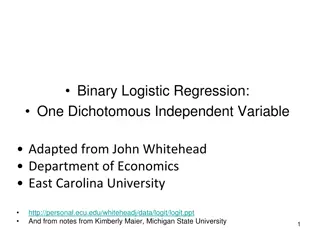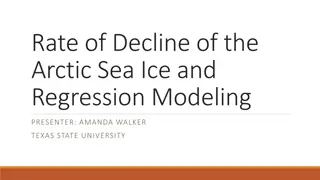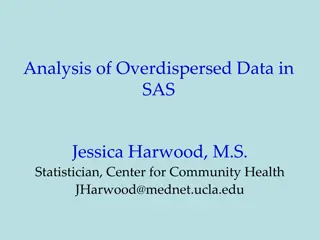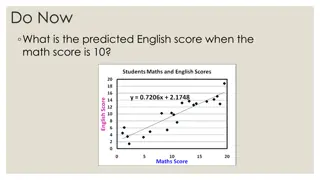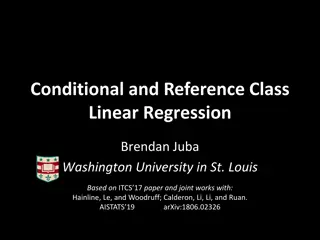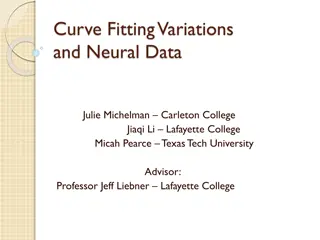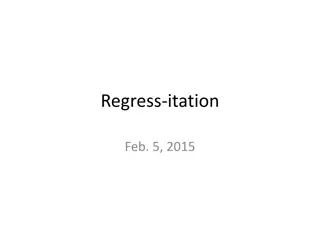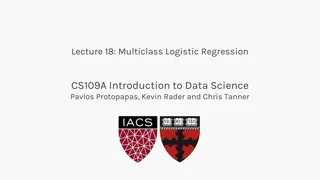Meta-Regression and Complex Data Structures Overview
From exploring meta-regression to understanding complex data structures, this course delves into estimating the impact of covariates on effect sizes. Dive into fixed and random-effects models, ANOVA tables, and fit tests, enhancing your knowledge of meta-analysis and covariate influence.
Download Presentation

Please find below an Image/Link to download the presentation.
The content on the website is provided AS IS for your information and personal use only. It may not be sold, licensed, or shared on other websites without obtaining consent from the author.If you encounter any issues during the download, it is possible that the publisher has removed the file from their server.
You are allowed to download the files provided on this website for personal or commercial use, subject to the condition that they are used lawfully. All files are the property of their respective owners.
The content on the website is provided AS IS for your information and personal use only. It may not be sold, licensed, or shared on other websites without obtaining consent from the author.
E N D
Presentation Transcript
EVAL 6970: Meta-Analysis Meta-Regression and Complex Data Structures Dr. Chris L. S. Coryn Spring 2011
Agenda Meta-regression In-class activity Complex data structures In-class activity
Meta-Regression Used to estimate the impact/influence of categorical and/or continuous covariates (moderators) on effect sizes or to predict effect sizes in studies with specific characteristics A ratio of 10:1 (studies to covariates) is recommended
Fixed-Effect Model Regression of Latitude on Log risk ratio 0.60 0.34 0.08 -0.18 Log risk ratio -0.44 -0.70 -0.96 -1.22 -1.48 -1.74 -2.00 8.80 13.84 18.88 23.92 28.96 34.00 39.04 44.08 49.12 54.16 59.20 Latitude
Fixed-Effect Model ANOVA information
Fixed-Effect Model ANOVA Table ? ?? 1 11 12 ? Model (??????) Residual (??????) Total (?) 121.49992 30.73309 152.23301 0.00000 0.00121 0.00000 ? = 152.233,?? = 12,? = 0.000, means that the total variance is greater than would be expected based on within-study error ??????= 121.499,?? = 1,? = 0.000, means that the relationship between the covariate and the effect is greater than would be expected by chance ??????= 30.733,?? = 11,? = 0.001, means that even with the covariate in the model, some of the between-studies variance is unexplained
Random-Effects Model Regression of Latitude on Log risk ratio 0.60 0.34 0.08 -0.18 Log risk ratio -0.44 -0.70 -0.96 -1.22 -1.48 -1.74 -2.00 8.80 13.84 18.88 23.92 28.96 34.00 39.04 44.08 49.12 54.16 59.20 Latitude
Random-Effects Model Fit Tests of the model Simultaneous test that all coefficients (excluding intercept) are zero ?????? ,??,? Goodness of fit test that all unexplained variance is zero ?2,??????,??,? =CHIDIST(?,??)
Proportion of Covariate Explained Variance In meta-analysis, the total variance includes both variance within studies and between studies Study-level covariates explain only the between-studies portion of the variance 2 ???????????? ?????? ?2= 1 2
Calculating ?2 2 ?????? Use the fixed-effect meta-analysis results (not meta-regression results)
Calculating ?2 Results from random-effects meta-regression using method of moments 2 ????????????
Variance Explained by Covariate Between studies (I2) 92% Within studies 8% Explained by covariate (R2) 79% Unexplained 21%
Todays First In-Class Activity From the BCG Meta-Regression.CMA data set Using a risk ratio as the effect size, conduct a random-effects meta-regression (with method of moments) regressing latitude on the risk ratio Write the regression equation, calculate the ?-test to estimate the impact of the slope, compute the LL and UL of ?, and calculate ?2 Interpret and explain the results
Complex Data Structures Main categories of complex data structures Independent subgroups within a study Multiple outcomes or time-points within a study Multiple comparisons within a study The first two are (relatively) easily handled in Comprehensive Meta- Analysis 2.0
Independent Subgroups within a Study When two or more independent subgroups (each of which contribute unique information) are reported within the same study, the options are 1. Compare effects between subgroups For two subgroups, ?-test For two or more subgroups, ?-test based on ANOVA ?-test for heterogeneity 2. Compute a summary effect for all subgroups combined
Combining Across Subgroups Option 1a (effect size is computed within subgroups) Treat each subgroup as a separate study Interest is in between-subgroup variation Option 1b (effect size is computed within studies) Compute a composite score and use the composite score for each study as the unit of analysis Interest is in between-study variation
Combining Across Subgroups Option 2 (ignore subgroup membership) Collapse across subgroups to compute a summary effect size and variance Subgroup membership is considered unimportant and is ignored (and its variance is not part of the summary effect size or standard error) Essentially a main effect meta-analysis
Multiple Outcomes or Time-Points within a Study When a study reports data on more than one outcome, or over more than one time- point, where outcomes or time-points are based on the same participants (i.e., dependent), the options are 1. Compute a composite effect size accounting for the correlation between outcomes or time-points 2. Compute a difference between outcomes or time-points accounting for the correlation between outcomes or time-points
Combining Outcomes or Time-Points The effect size for two outcomes or time-points is computed as ? =1 2(?1= ?2) With variance of the combined mean ? ?=1 4(??1+ ??2+ 2? ??1??2
Combining Outcomes or Time-Points For more than two outcomes or time- points ? =1 ? ? ?? ? With variance of ? 2 1 ? ? ?= ??+ ??? ??1??2 ?=1 ? ?
Combining Outcomes or Time-Points The problem is that ? often is not known (e.g., not reported in a study) If ? is unknown, the only solution is to use a plausible value or range of values (sensitivity) Similarity (or dissimilarity) of outcomes Time elapsed between time-points and stability of relative scores over time By default, Comprehensive Meta-Analysis 2.0 sets ? to 1.00 (which may overestimate the variance and underestimate precision)
Comparing Outcomes or Time-Points within a Study The effect size for the difference between two outcomes or time- points is computed as ?????= ?1 ?2 With variance ?????= ??1+ ??2 2? ??1??2
Comparing Outcomes or Time-Points As before, the problem is that ? often is not known (e.g., not reported in a study) If ? is unknown, the only solution is to use a plausible value or range of values (sensitivity) By default, Comprehensive Meta- Analysis 2.0 sets ? to 0.00 (which may overestimate the variance and underestimate precision of the difference)
Multiple Comparisons within a Study When a study reports multiple comparisons between more than two (dependent) groups (e.g., treatment variant A, treatment variant B, and control group C), the options are 1. Compute a summary effect for the active intervention (combing A and B) versus control (C); the same as option 2 for independent subgroups 2. Compute a difference for interventions A and B (ignoring C)
Todays Second In-Class Activity From the Complex Data Structures Multiple Outcomes or Time- Points.CMA data set Conduct fixed-effect analyses (1) using composite effect sizes within studies and (2) treating each outcome as the unit of analysis Interpret and explain both analyses (including all relevant statistical tests)
